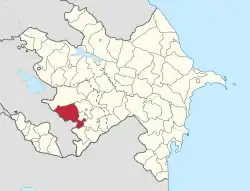Lachin
Lachin (Azerbaijani: Laçın ![]() (listen), literally "falcon", Armenian: Բերձոր, romanized: Berdzor) is a town within the strategic Lachin corridor, which connects Nagorno-Karabakh with Armenia, and is under the supervision of the Russian peacekeeping force following the ceasefire agreement, ending the Second Nagorno-Karabakh war. The town is de jure centre of the Lachin District of Azerbaijan, and it was de facto under the occupation of the self-proclaimed Republic of Artsakh since 1992 as part of its Kashatagh Province.[3] According to the Azerbaijani president Ilham Aliyev, a new corridor will be built in the region as the Lachin corridor passes through the city of Lachin, and when this corridor is ready, the city will be returned to the Azerbaijani administration.[4]
(listen), literally "falcon", Armenian: Բերձոր, romanized: Berdzor) is a town within the strategic Lachin corridor, which connects Nagorno-Karabakh with Armenia, and is under the supervision of the Russian peacekeeping force following the ceasefire agreement, ending the Second Nagorno-Karabakh war. The town is de jure centre of the Lachin District of Azerbaijan, and it was de facto under the occupation of the self-proclaimed Republic of Artsakh since 1992 as part of its Kashatagh Province.[3] According to the Azerbaijani president Ilham Aliyev, a new corridor will be built in the region as the Lachin corridor passes through the city of Lachin, and when this corridor is ready, the city will be returned to the Azerbaijani administration.[4]
Lachin
Laçın Բերձոր • Berdzor | |
|---|---|
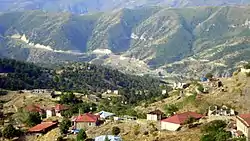 | |
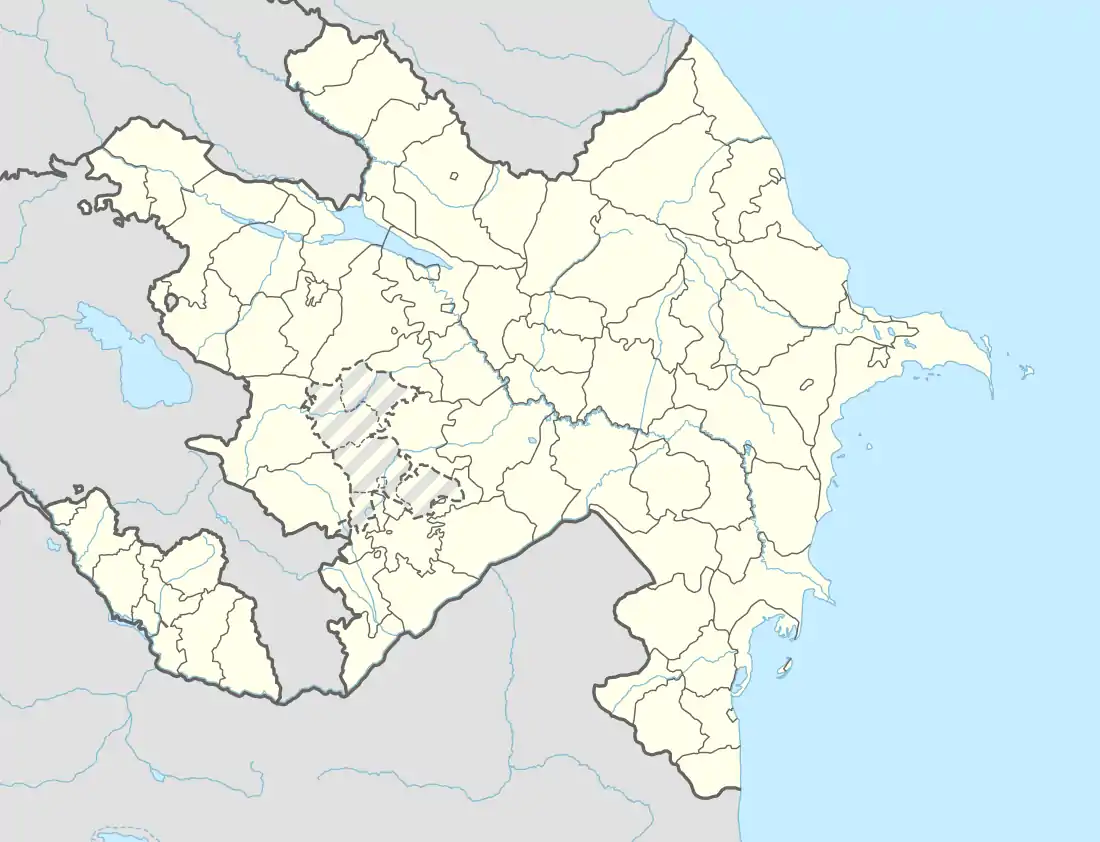 Lachin  Lachin | |
| Coordinates: 39°38′27″N 46°32′49″E | |
| Country | |
| District | Lachin (de jure) |
| Province | Kashatagh (de facto) |
| Government | |
| • Mayor | Narek Alexanyan[1] |
| Population (2015) | |
| • Total | 1,900[2] |
| Time zone | UTC+4 (UTC) |
History
The town was formerly known as Abdallar, named after the Turkic Abdal tribe, until it was granted town status in 1923 and then renamed Lachin (a Turkic first name meaning falcon) in 1926.[5][6]
In the early 1920s, Vladimir Lenin's letter to Narimanov "had implied that Lachin was to be included in Azerbaijan, but the authorities in Baku and Yerevan were given promises that were inevitably contradictory."[7] The town of Lachin on 7 July 1923 became the administrative centre of Kurdistansky Uyezd of Azerbaijan SSR, often known as Red Kurdistan before it was moved to Shusha.[8] It was dissolved on 8 April 1929: Kurdish schools and newspapers were closed.[9]
On 30 May 1930, the Kurdistan Okrug replaced the uyezd. It included the territory of the former Kurdistansky uyezd, as well as Zangilansky District and a part of Dzhebrailsky District. The okrug, like the uyezd before it, was founded to appeal to Kurds beyond Soviet borders in Iran and Turkey, but the Soviet Ministry of Foreign Affairs would ultimately protest this policy due its negative effect on relations with Turkey and Iran. Due to these concerns, the okrug was abolished less than a month after its foundation, on 23 July 1930.[10]
In the late 1930s, Soviet authorities deported most of the local Kurdish population as well as much of the Kurds elsewhere in Azerbaijan and Armenia to Kazakhstan.[11]
First Nagorno-Karabakh war
Town of Lachin and the surrounding district were the locations of severe fighting during the First Nagorno-Karabakh war in 1990–1994, and the town has not wholly recovered from the destruction of that war.[12] Lachin has significant importance because of the Lachin corridor, which links Armenia to Nagorno-Karabakh.[13]
Following the city's capture by Armenian forces, it was burned down[14] and all of its original 7,800 Azerbaijani and Kurdish populations became internally displaced people as a result of forceful deportations.[15]
Armenian occupation
From 1992, Lachin was administrated by the self-proclaimed Republic of Artsakh as part of its Kashatagh Province. Artsakh repopulated the city by attracting settlers from Armenia and Lebanon.[15][14]
The OSCE Minsk Group co-chairs had noted that "Lachin has been treated as a separate case in previous negotiations." The Lachin corridor and the Kalbajar district had been at the centre of Armenian demands during the Nagorno-Karabakh peace talks with Azerbaijan.[16]
On 16 June 2015 European Court of Human Rights passed a judgement in the case of "Chiragov and Others v. Armenia", which concerned the complaints by six Azerbaijani ethnically-Kurdish refugees that they were unable to return to their homes and property in the district of Lachin, in Azerbaijan, from where they had been forced to flee in 1992 during the Armenian-Azerbaijani conflict over Nagorno-Karabakh. The Court confirmed that Armenia exercised effective control over Nagorno-Karabakh and the surrounding territories and thus had de facto jurisdiction over the district of Lachin, however, the Court also found that the denial by the Armenian Government of access to the applicants’ homes constituted an unjustified interference with their right to respect for their private and family lives as well as their homes.[17]
2020 Nagorno-Karabakh war
Following the ceasefire agreement ending the 2020 Nagorno-Karabakh war, the Lachin District was set to be returned to Azerbaijan on 1 December, with Russian peacekeepers securing the Lachin corridor which passes thorough the town.[18] However, the unclear and unstable situation in the region have caused many Armenians to evacuate from the city.[14]
The Artsakh mayor of Lachin, Narek Aleksanyan, first called on the ethnic Armenian population of the town to evacuate. However, later Aleksanyan stated that the agreement had been changed and that Lachin, Sus, and Zabux which are located inside the Lachin corridor would not be handed over to Azerbaijan, urging the Armenian population to stay in their homes. Despite Aleksanyan's calls, the vast majority of Armenians in Lachin, as well as Lebanese-Armenians in Zabux fled the region.[19][20]
Azerbaijani MP Zahid Oruj, the chairman of the Center for Social Research, which is linked to the Azerbaijani government, denied that the Lachin district would not be handed over in its entirety.[19]
On December 1, Azerbaijani forces, with tanks and a column of trucks, entered the district,[21] and the Azerbaijani MoD released footage from the Lachin district.[22] On December 3, Azerbaijani Ministry of Defence released video footage from the town of Lachin.[23]
Demographics
| Year | Population | Ethnic groups | Source |
|---|---|---|---|
| 1926 | 435 | 37.7% Turks (now Azerbaijanis), 25.3% Kurds, 15.2% Armenians, 13.1% Russians | Soviet census[24] |
| 1939 | 1,063 | 80.7% Azerbaijani, 11.6% Armenians, 6.4% Russians | Soviet census[25] |
| 1959 | 2,329 | 94.5% Azerbaijani, 4.3% Armenians 1% Russians | Soviet census[26] |
| 1970 | 4,990 | 95% Azerbaijani, 2.7% Russians & Ukrainians, 1.1% Armenians | Soviet census[27] |
| 1979 | 6,073 | 99.1% Azerbaijani | Soviet census[28] |
| 1989 | 7,829 | Soviet census[29] | |
| 2005 | 2,190 | ~100% Armenians | NKR census[30] |
| 2015 | 1,900 | ~100% Armenians | NKR estimate[2] |
Terrain
The town is scenically built on the side of a mountain on the left bank of Hakari River.[31]
Gallery
 View of the town
View of the town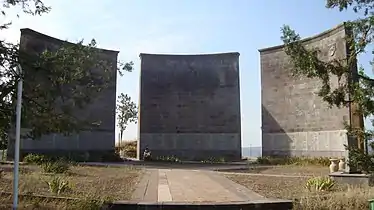 Former WW2 memorial turned into Nagorno-Karabakh conflict memorial
Former WW2 memorial turned into Nagorno-Karabakh conflict memorial Playground in the town
Playground in the town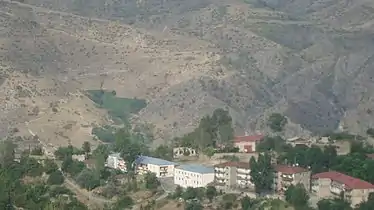 View of part of Lachin
View of part of Lachin Road in Lachin
Road in Lachin Building of Armenian mobile operator company
Building of Armenian mobile operator company.jpg.webp) Holy Ascension Church in Berdzor opened in 1998.
Holy Ascension Church in Berdzor opened in 1998.
References
Notes
- https://armenpress.am/eng/news/1036360/D090D180D0BCD0B5D0BDD0BFD180D0B5D181D181
- "Urban communities of the NKR" (PDF). stat-nkr.am. National Statistical Service of Nagorno-Karabakh Republic. January 1, 2015. p. 13.
- "Rusiya Müdafiə Nazirliyi: Laçın dəhlizində hərəkətə sülhməramlılar nəzarət edir". BBC Azerbaijani Service (in Azerbaijani). December 1, 2020. Retrieved December 1, 2020.
- "İlham Əliyev: "Yeni dəhliz hazır olandan sonra Laçın şəhəri bizə qaytarılacaq"". BBC Azerbaijani Service (in Azerbaijani). December 1, 2020. Retrieved December 4, 2020.
- "ЛАЧИН". dic.academic.ru.
- Pospelov, p. 23
- Alexandre Bennigsen and S. Enders Wimbush. Muslims of the Soviet Empire. C. Hurst & Co Publishers, 1986, pp. 202, 286. ISBN 1-85065-009-8.
- McDowall, David. A Modern History of the Kurds, 3rd. ed. London: I.B. Tauris, 2004, p. 492.
- Catherine Cosman, "Soviet Kurds Face Loss of Their Identity," New York Times, May 13, 1991/June 2, 1991.
- (in Russian) Партизаны на поводке.
- (in Russian) Russia and the problem of Kurds Archived February 12, 2012, at the Wayback Machine
- "Азербайджан взял под контроль Лачин спустя 28 лет". Caucasian Knot (in Russian). December 1, 2020. Retrieved December 1, 2020.
- "Azerbaijani troops enter Lachin district in Nagorno-Karabakh". TASS. November 30, 2020. Retrieved December 1, 2020.
- Vendik, Yuri (November 17, 2020). "Армяне оставляют Лачин, несмотря на конец войны в Карабахе и прибытие российских миротворцев". BBC Russian Service (in Russian). Retrieved December 1, 2020.
- "Laçın – məğrur rayonun hekayəsi". BBC Azerbaijani Service (in Azerbaijani). December 1, 2020. Retrieved December 1, 2020.
- CountryWatch - Interesting Facts Of The World Archived September 28, 2007, at the Wayback Machine
- Press release issued by the Registrar of the Court. "Azerbaijani refugees' rights violated by lack of access to their property located in district controlled by Armenia". European Court of Human Rights. Retrieved June 21, 2015.
- "Rusiya Müdafiə Nazirliyi: Laçın dəhlizində hərəkətə sülhməramlılar nəzarət edir". BBC Azerbaijani Service (in Azerbaijani). December 1, 2020. Retrieved December 1, 2020.
- "Laçın şəhəri ermənilərdəmi qalır? Ermənilərə belə deyilib, amma onlar şəhəri tərk edir". BBC Azerbaijani Service (in Azerbaijani). November 30, 2020. Retrieved December 1, 2020.
- https://armenpress.am/eng/news/1036360/D090D180D0BCD0B5D0BDD0BFD180D0B5D181D181
- "Azerbaijani Forces Enter Third District Under Nagorno-Karabakh Truce". RFERL.org. Radio Free Europe/Radio Liberty. December 1, 2020.
- "Azərbaycan Müdafiə Nazirliyi Laçında dövlət bayrağının asılması barədə video yayıb". BBC Azerbaijani Service (in Azerbaijani). December 1, 2020. Retrieved December 1, 2020.
- "Laçın şəhərinin videogörüntüləri".
- "Курдистанский уезд 1926". www.ethno-kavkaz.narod.ru.
- "Лачинский район 1939". www.ethno-kavkaz.narod.ru.
- "Лачинский район 1959". www.ethno-kavkaz.narod.ru.
- "Лачинский район 1970". www.ethno-kavkaz.narod.ru.
- "Лачинский район 1979". www.ethno-kavkaz.narod.ru.
- "Демоскоп Weekly - Приложение. Справочник статистических показателей". demoscope.ru.
- http://census.stat-nkr.am/nkr/1-1.pdf
- "Great Soviet Encyclopedia". yandex.ru.
- "Azerbaijan Protests California Town’s Recognition of Nagorno-Karabakh." RIA Novosti. December 6, 2013.
Sources
- Е. М. Поспелов (Ye. M. Pospelov). "Имена городов: вчера и сегодня (1917–1992). Топонимический словарь." (City Names: Yesterday and Today (1917–1992). Toponymic Dictionary." Москва, "Русские словари", 1993.
External links
| Wikimedia Commons has media related to Lachin. |
- Pictures of Lachin
- Onnik Krikorian, Armenia’s Strategic Lachin Corridor Confronts a Demographic Crisis, eurasianet.org, Sep 15, 2006.
- More information about Lachin from Armeniapedia.com
- "Lachin". Azerb.com. Retrieved February 4, 2007.
- "History of Artsakh (Part 3)". Archived from the original on September 1, 2009. Retrieved May 27, 2008.
- Lachin (as Laçın) at GEOnet Names Server

